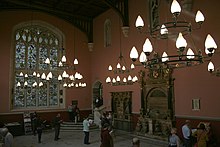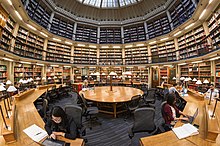Maughan Library
| Maughan Library, King's College London | |
|---|---|
| Size | 750k items (approx.)[2] |
| Access and use | |
| Access requirements | Students and staff of King's College London and other University of London colleges, some SCONUL Access Card holders and members of the public with legitimate research needs |
| Other information | |
| Budget | £5,087,981 (Expenditure on print and electronic resources across all branches 2011–12)[3] |
| Director | Lis Hannon |
| Website | kcl.ac.uk/library |
The Maughan Library (/mɔːn/) is the main university research library of King's College London, forming part of the Strand Campus. A 19th-century neo-Gothic building located on Chancery Lane in the City of London, it was formerly the home to the headquarters of the Public Record Office, known as the "strong-box of the Empire",[4] and was acquired by the university in 2001. Following a £35m renovation designed by Gaunt Francis Architects, the Maughan is the largest new university library in the United Kingdom since World War II.[5]
Designed by
History

Early history
The library building seen today was built in 1851, however, its roots date back to the 13th century.
Rolls Chapel

The Maughan occupies the site of the
In 1278, in a letter given to the king by John the Convert, the Converts referred to themselves as Pauperes Cœlicolæ Christi.
Following the expulsion of Jews from England by
The chapel was rebuilt in 1617 by
There are three principal tomb monuments. The first commemorates John Yonge (d.1516), Master of the Rolls in the early part of the reign of Henry VIII. The work of Pietro Torrigiano (who also made the tomb of Henry VII in Westminster Abbey), it features a recumbent effigy with hands crossed, wearing a red gown and square cap.[9] The second, attributed to the Cure workshop, commemorates Richard Allington (d.1561) and his wife: it includes kneeling figures of the couple facing one another across a prayer-desk, on the front of which are depicted in relief their three daughters, also kneeling.[15] The third monument, attributed to Maximilian Colt, is that of Edward Bruce, 1st Lord Kinloss (d.1611), whose semi-recumbent effigy wears a long-furred robe: below him are four kneeling figures, including a man in armour, perhaps his son, Edward.[9][15]

Rolls House
Rolls House was the official residence of the Master of the Rolls and remained in the possession of the office until 1837, when it was surrendered to the Crown.[6]
Public Record Office


In 1838 the Public Record Office Act was passed to "keep safely the public records".
University library


In 2001 King's College London acquired the building from the
The surviving part of the chapel is called the Weston Room, following a donation from the
The building has 1,250 networked reader places in a variety of environments including individual study carrels and group study rooms.[28][29]
Holdings
The Maughan holds more than 750,000 items including books, journals, CDs, records, DVDs, theses and exam papers.
Foyle Special Collections Library
The library is also home to the Foyle Special Collections Library, named in recognition of a grant from the
- HG Adler Collection
- Jeremy Adler Collection
- Box Collection
- The Carnegie Collection of British Music
- Cohn Collection
- College Collection
- De Beer Collection
- Early Science Collection
- The Foreign and Commonwealth OfficeHistorical Collection
- Guy's Hospital Physical Society Collection
- Institute for the Study and Treatment of Delinquency Collection
- King's College School of Medicine and DentistryHistorical Collection
- Miscellaneous Collection
- Rainbow Collection
- Reginald Ruggles Gates Collection
- The Stebbing Collection
- St Thomas' Hospital Historical Collection
- Wheatstone Collection

Liddell Hart Centre for Military Archives
Established in 1964, the Liddell Hart Centre for Military Archives (LHCMA) is a leading repository for research into modern defence policy in the United Kingdom. The collections are of national and international importance and were awarded
Garden

The garden opposite the library was originally owned by
In fiction
The dodecagonal reading room is one of the locations consulted by Robert Langdon and Sophie Neveu in chapters 92 and 95 of the Dan Brown novel, The Da Vinci Code.[2] The library was also used as a filming location for exterior shots of the Tower of London in the 2003 film, Johnny English.[40] Part of the music video of the song Twilight's Chapter Seven from the album Still Fantasy by Taiwanese musician Jay Chou was filmed at the Maughan.[41] The use of the round reading room as a filming location for Dumbledore's Office in the Harry Potter films has been the source of considerable talk and rumour,[42][citation needed] however, a feature in an edition of the King's Library Newsletter confirms that this is in fact a myth, though the library receives several requests to film each month.[43] The exterior of the building appears in the 2020 film Enola Holmes.[44]
Residence
The top floor of the Chancery Lane wing of the library building is used as a residence for the Principal of King's College London during their term.[45]
References
- ^ "Contact us". King's College London. Retrieved 27 February 2013.
- ^ a b c d e Strand Campus Tour (PDF), London: King's College London, p. 6, retrieved 25 February 2013
- ^ King's College London Library Services (2011), Library Services Annual Report 2011-12 (PDF), King's College London, p. 39, archived from the original (PDF) on 19 June 2013, retrieved 18 March 2013
- ^ "About the building" (PDF). London: King's College London. October 2012. Retrieved 19 January 2013.
- ^ a b O'Leary (2010), p. 404
- ^ a b c Lyte (1907), p. 1
- ^ Adler, p. 2
- King Richard the Third, in 1484; those before that Time are kept in Wakefield Tower, in the Tower of London; but at first here was founded by King Henry the Third, in 1233, an House of converted Jews upon a Jew's House, which had been formerly confiscated to the Crown. Pr.[ayers] and S.[ermons] are every Sunday Morning in Term Time at 10, and only Pr.[ayers] at 3, and on Holydays at 10 and 3; Sac.[rament] every second Sunday of the 4 Terms, on Christmas day, Easter Sunday, and Whitsunday."
- ^ a b c d e f Thornbury, Walter (1878). "Fleet Street: Northern tributaries - Chancery Lane". Old and New London: Volume 1. pp. 76–92. Retrieved 19 October 2021.
{{cite book}}:|website=ignored (help) - ^ Adler, p. 4.
- ^ a b Sibbald (1800), p. 356.
- ^ Chancery Lane Association. "Chancery Lane Area Enhancement Scheme" (PDF). City of London. p. 12. Archived from the original (PDF) on 2 September 2012. Retrieved 14 March 2013.
- ^ Chancery Lane Association. "Chancery Lane Area Enhancement Scheme" (PDF). City of London. p. 12. Archived from the original (PDF) on 2 September 2012. Retrieved 14 March 2013.
- ^ a b c Hibbert, Weinreb, Keay, Keay (2008), p. 698.
- ^ a b Bradley and Pevsner 1997, p. 328.
- ^ "History of the Public Records Act". National Archives. Retrieved 25 February 2013.
- ^ Dewe (2009), p. 223
- ^ "King's College London, The Maughan Library". London: Open City. Archived from the original on 3 July 2013. Retrieved 25 February 2013.
- ^ "Weston Room" (PDF). London: King's College London. October 2012. Retrieved 25 February 2013.
- ^ Lyte (1907), p. 3
- ^ Darby, Trudi & Bell (2002), pp. 56–63
- ^ "£4m Gift for King's", Comment (Issue No. 140) (PDF). London: King's College London. March 2002. p. 2.
- ^ a b "Maughan Library" (PDF). Tuffin Ferraby Taylor LLP. Retrieved 19 January 2013.
- ^ "£4m Gift for King's", Comment (Issue No. 140) (PDF). London: King's College London. March 2002. pp. 1–2.
- ^ "King's College London". The Independent. London. 1 July 2012. Archived from the original on 12 May 2022. Retrieved 19 January 2013.
- ^ a b "C18th volumes presented to King's". London: King's College London. 22 November 2002. Retrieved 25 February 2013.
- ^ Plaque beneath display.
- ^ MacLeod, Donald (14 November 2002). "Queen welcomed by King's". The Guardian. Retrieved 18 March 2013.
- ^ "King's takes part in the London Open House Weekend". King's College London. 15 September 2003. Retrieved 18 March 2013.
- ^ "Details of King's Sound Archive at Cecilia". Cecilia. Retrieved 9 October 2007.
- ^ a b c "About us – Archives & Special Collections". London: King's College London. Retrieved 25 February 2013.
- ^ a b "Special Collections". King's College London. Retrieved 19 January 2013.
- ^ "Carnegie Collection of British Music". London: King's College London. Retrieved 19 January 2013.
- ^ "Incunabula at King's". King's College London. Retrieved 25 February 2013.
- ^ "Liddell Hart Centre for Military Archives". London: King's College London. Retrieved 25 February 2013.
- ^ a b London Parks & Gardens Trust (1 June 2010). "Site details: King's College London Strand Campus, Maughan Library and Information Services Centre". London. Retrieved 26 February 2013.
- ^ "King's China Institute launched". London: King's College London. 25 October 2010. Retrieved 26 February 2013.
- ^ "Building work adjacent to the Maughan Library". King's College London. Retrieved 25 July 2016.
- ^ "The case for buying in London's legal heartland – Chancery Lane". Financial Times. 23 October 2015. Retrieved 25 July 2016.
- ^ "Johnny English (2003)". British-Film-Locations.com. Retrieved 28 February 2013.
- ^ Jay Chou (2006). 夜的第七章 [Twilight's Chapter Seven] (Video) (in Taiwanese Hokkien). Event occurs at 2m 46s. Archived from the original on 12 December 2021. Retrieved 28 February 2013 – via YouTube.
- ^ "K+ "10 facts about King's"" (PDF). London: King's College London. p. 15. Retrieved 25 February 2013.
- ^ "King's Library Newsletter" (PDF). Spring 2013. p. 4. Retrieved 26 September 2013.
- ^ Fox, Caroline (26 October 2020). "Every Enola Holmes Filming Location (And What Every Place Looks Like Now)". ScrenRant.com. Retrieved 29 November 2020.
- ^ "King's student sneaks into Principal's secret Maughan flat". Roar News. 1 December 2014. Retrieved 24 July 2016.
Bibliography
- Adler, Michael. History of the "Domus Conversorum" from 1290 to 1891. London: Ballantyne, Hanson & Co.
- Bradley, Simon; ISBN 0-14-071092-2.
- Darby, Trudi & Bell, Anne (2002). "Ancient and modern: the Maughan Library", Report (Issue No. 10). London: King's College London. pp. 56–63.
- Dewe, Michael (2009). Renewing Our Libraries: Case Studies in Re-Planning and Refurbishment. Ashgate Publishing Limited. ISBN 978-0-7546-7339-2.
- C. Hibbert; B. Weinreb; J. Keay; J. Keay (2008). The London Encyclopedia (3rd ed.). Pan Macmillan. p. 958. ISBN 9780230738782.
- Maxwell Lyte, H. C. (1907). Catalogue of Manuscripts and Other Objects in the Museum of the Public Record Office, with brief descriptive and historical notes (4th ed.). London: HMSO.
- O'Leary, John (2010). The Times Good University Guide 2011. London. ISBN 9780007356140. Retrieved 19 January 2013.)
{{cite book}}:|work=ignored (help)CS1 maint: location missing publisher (link - Sibbald, J. (1800). Edinburgh Magazine: Or Literary Miscellany. Vol. 15. Murray and Highley, Fleet Street. p. 356.
- Stow, William (1722). Remarks on London: being an exact survey of the cities of London and Westminster, Borough of Southwark. London: Printed for T. Norris and H. Tracy. p. 121.
- "£4m Gift for King's", Comment (Issue No. 140) (PDF). London: King's College London. March 2002. pp. 1–2.
- Strand Campus Tour (PDF), London: King's College London, retrieved 25 February 2013
- King's College London Library Services (2011), Library Services Annual Report 2011-12 (PDF), King's College London, archived from the original (PDF) on 19 June 2013, retrieved 18 March 2013
